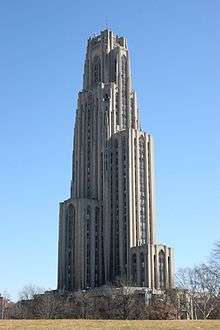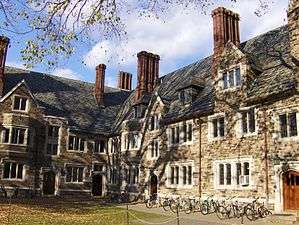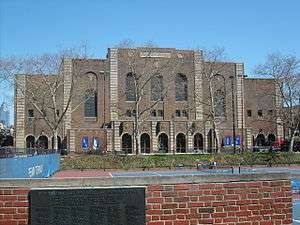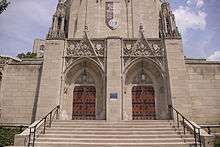Charles Klauder
| Charles Klauder | |
|---|---|
| Born |
Charles Zeller Klauder February 9, 1872 Philadelphia, Pennsylvania, U.S. |
| Died |
October 30, 1938 (aged 66) Philadelphia, Pennsylvania, U.S. |
| Nationality | American |
| Alma mater | School of Industrial Art (Philadelphia) |
| Occupation | Architect |
| Practice |
|
| Buildings | See below |
| Projects | Academic buildings |
| Signature | |
|
| |
Charles Zeller Klauder (February 9, 1872 – October 30, 1938) was an American architect best known for his work on university buildings and campus designs, especially his Cathedral of Learning at the University of Pittsburgh, the first educational skyscraper.
Biography
Born in Philadelphia, Pennsylvania, Klauder was the son of Louis and Anna Koehler Klauder, who had immigrated to Philadelphia from Germany. He studied architecture at the School of Industrial Art at the Pennsylvania Museum. At age 15, he entered the office of Theophilus Parsons Chandler, Jr. Beginning in 1893 he worked for prominent Philadelphia architectural firms, including Wilson Brothers & Company, Cope & Stewardson, and Horace Trumbauer. In 1900, Klauder became chief draughtsman at Day & Brother, which led to the 1911 partnership with Frank Miles Day, and the firm's renaming as Day & Klauder. Klauder continued the firm after Day's 1918 death, but did not rename it until 1927.
Klauder's commissions include extensive work on the University of Pittsburgh, University of Pennsylvania, Penn State University, Rhodes College in Memphis, Tennessee, the University of Colorado Boulder, and Cornell University. At Penn he designed the third Franklin Field, Hutchinson Gymnasium, the Coxe and Sharpe Wings of the University Museum, alterations to Weightman Hall and the Palestra. Several of his landmark Neo-Gothic buildings at Pitt are the Cathedral of Learning, Heinz Memorial Chapel and the Stephen Foster Memorial. The Cathedral of Learning, upon its completion, was the tallest educational building in the world, and today it ranks behind only a tower at Moscow University. It is also listed on the National Register of Historic Places.
The Marks Scout Resource Center at 22nd and Winter Streets in Philadelphia was built in 1929. Klauder designed the building in the Beaux Arts style.[1]
For his lifelong architectural work, Klauder has received the Gold Medal, Architectural League, N.Y. 1921; Grand Prix Pan American Congress of Architects, 1927; Architectural Medal, Olympic Games, 1928. Klauder was a Fellow of the American Institute of Architects. In 1938 he was elected into the National Academy of Design as an Associate Academician.
Klauder died aged 66 on October 30, 1938.
Architectural Work (Partial listing)
University of Colorado Boulder
- Campus master plan, University of Colorado, 1918. 15 buildings of the University of Colorado Boulder in the Tuscan Vernacular Revival style, characterized by rough, textured sandstone walls with sloping, multi-leveled red-tiled roofs and Indiana limestone trim, were designed by Klauder between 1921 and 1939. The oldest buildings of the CU-Boulder campus, such as Old Main (1876) and Macky Auditorium (1923), are in the Collegiate Gothic style of many East Coast schools.
- Norlin Library, final building designed by Klauder on the CU Boulder campus, 1939
Concordia Seminary, Clayton, Missouri
14 buildings including:
Cornell University
- Founders Hall
- Lyon Hall, 1928
- McFaddin Hall, 1928
- War Memorial, 1928
- Mennen Hall, 1931
Franklin and Marshall College
- Dietz-Santee Dormitory
- Franklin-Meyran Dormitory
- Biesecker Gymnasium
- Hensel Auditorium
- Fackenthal Laboratories, now the Harris Center for Business, Government, and Public Policy
- Central Heating Plant
- Fackenthal Pool
- Franklin and Marshall College Master Plan
University of Pennsylvania
- Franklin Field 1922, 1925
- Palestra
- Hutchinson Gymnasium, 1926–1928
- Coxe 1926 and Sharpe 1929 Wings of the University Museum
- Alterations to Weightman Hall
University of Pittsburgh
- Cathedral of Learning 1926-1937
- Heinz Memorial Chapel 1933-1938
- Stephen Foster Memorial 1937
Princeton University
15 buildings including:
- Walker Hall, 1930
- Holder Hall, 1909, Day & Brother.
- University Dining Halls, 1916, Day & Klauber.
- Joline Hall, 1939
St. Paul's School
- Central Heating Plant
- Quadrangle Dorms
Pennsylvania State University
- College Master Plan
- Sackett Building
- Buckhout and Borland Labs
- Steidle Building
- The Nittany Lion Inn
- Additions to Pond Lab and Sparks Building
- The Power Plant
- Henderson Building
- (New) Old Main
- Rec Hall
- Pattee Library
- Burrowes Building
- Electrical Engineering West
- Osmond and Frear Labs
- Ag Engineering
- Ferguson Building
- The Poultry Plant
- Additions to Steidle and Sparks
University of Chicago
- Eckhart Hall
Other academic buildings
- Peabody Museum, Yale University, 1916-24.
- Main Hall and Dormitory, Mercersburg Academy, 1927.
- Pendleton Hall, Wellesley College, 1934.
- Library, Albion College, 1937.
Non-academic buildings
- First Presbyterian Church, Kalamazoo, Michigan, 1926-30.
- Marks Boy Scout Resource Center, Philadelphia, 1929-30.
- Railroad Retirement Board Building, Washington, D.C., with Louis A. Simon, 1939.
Gallery

.jpg)
 Holder Hall, Princeton University (1909), Day & Brother, architects.
Holder Hall, Princeton University (1909), Day & Brother, architects.



 War Memorial, Cornell University
War Memorial, Cornell University
Bibliography
- Klauder, Charles Z.; Wise, Herbert C. (1929). College Architecture in America. New York: Charles Scribner's Sons. ASIN B002R1JZJ2.
Notes
- ↑ "Boy Scouts of America Building". Philadelphia Architects and Buildings. Retrieved 19 November 2015.
References
- Alberts, Robert C. (1987). Pitt: The Story of the University of Pittsburgh 1787-1987. Pittsburgh: University of Pittsburgh Press. ISBN 978-0822962359.
External links
| Wikimedia Commons has media related to Charles Klauder. |
- Charles Z. Klauder Collection at the Carnegie Mellon University Architecture Archives